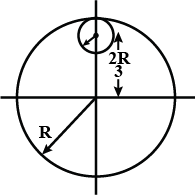JEE Main Mock Test - 2 - JEE MCQ
30 Questions MCQ Test Mock Tests for JEE Main and Advanced 2025 - JEE Main Mock Test - 2
A small soap bubble of radius 4 cm is trapped inside another bubble of radius 6 cm without any contact. Let P2 be the pressure inside the inner bubble and P0 be the pressure outside the outer bubble. Radius of another bubble with pressure difference P2 - P0 between its inside and outside would be
A planet of mass M is revolving around sun in an elliptical orbit. If dA is the area swept in a time dt, angular momentum can be expressed as
| 1 Crore+ students have signed up on EduRev. Have you? Download the App |
A particle is projected upward from the surface of earth (radius = R) with a speed equal to the orbital speed of a satellite near the earth’s surface. The height to which it would rise is
A spherical hole is made in a solid sphere of radius R. The mass of the original sphere was M.The gravitational field at the centre of the hole due to the remaining mass is
Three particles P, Q and R placed as per given figure. Masses of P, Q and R are √3 m, √3 m and m respectively. The gravitational force on a fourth particle ‘S’ of mass m is equal to
A cylindrical tank has a hole of diameter 2r in its bottom. The hole is covered wooden cylindrical block of diameter 4r, height h and density ρ/3.
Situation I : Initially, the tank is filled with water of density ρ to a height such that the height of water above the top of the block is h1 (measured from the top of the block).
Situation II : The water is removed from the tank to a height h2 (measured from the bottom of the block), as shown in the figure.
The height h2 is smaller than h (height of the block) and thus the block is exposed to the atmosphere.

Q. Find the minimum value of height h1 (in situation 1), for which the block just starts to move up?
If the elastic limit of copper is 1.5 × 108 N/ m2, determine the minimum diameter a copper wire can have under a load of 10.0 kg if its elastic limit is not to be exceeded.
A circular steel wire 2.00 m long must stretch no more than 0.25 cm when a tensile force of 400 N is applied to each end of the wire. What minimum diameter is required for the wire?
At what temperature is the r.m.s velocity of a hydrogen molecule equal to that of an oxygen molecule at 47°C?
Heat generated through a resistive wire will increase _______ times in unit time, if current in the wire becomes twice.
Suppose that the angular velocity of rotation of Earth is increased. Then, as a consequence,
From a uniform circular disc of radius R and mass 9M, a small disc of radius R/3 is removed as shown in the figure. The moment of inertia of the remaining disc about an axis perpendicular to the plane of the disc and passing through the centre of disc is

A wire of length 2.5 m and area of cross section 1×10–6 m2 has a mass of 15 kg hanging on it. What is the extension produced? How much is the energy stored in the standard wire if Young’s modulus of wire is 2×1011 Nm–2.
Find the height of the geostationary satellite above the earth assuming earth as a sphere of radius 6370 km.
A metal in a compound can be displaced by another metal in the uncombined state. Which metal is a better reducing agent in such a case?
The complex [Fe(H2O)5NO]2+ is formed in the ring-test for nitrate ion when freshly prepared FeSO4 solution is added to aqueous solution of
followed by the addition of conc. H2SO4. NO exists as NO+ (nitrosyl).
Q. Magnetic moment of Fe in the ring is
The pKa of a weak acid, HA, is 4.80. The pKb of a weak base, BOH, is 4.78. The pH of an aqueous solution of the corresponding salt, BA, will be -
[AIEEE-2008]
In aqueous solution the ionization constants for carbonic acid are K1 = 4.2 x 10-7 and K2 = 4.8 x 10-11 Selection the correct statement for a saturated 0.034 M solution of the carbonic acid.
[AIEEE-2010]
For the following electrochemical cell reaction at 298 K,
E°cell = 1.10 V
We know that the relationship between Kc and Kp is Kp = Kc (RT)Δn
What would be the value of Δn for the reaction NH4Cl (s) ⇔ NH3 (g) + HCl (g)
Calculate the standard heat of formation of propane, if its heat of combustion is −2220.2 KJmol−1 the heats of formation of CO2 (g) and H2O(1) are −393.5 and −285.8 kJ mol−1 respectively.
For the reaction at 298 K: 2A +B → C
ΔH = 400 J mol−1; ΔS = 0.2 JK−1mol−1
Determine the temperature at which the reaction would be spontaneous.
In the expansion of (1+x)60, the sum of coefficients of odd powers of x is
The mid points of the sides of a triangle are (5, 0), (5, 12) and (0, 12), then orthocentre of this triangle is
The average age of a husband and his wife was 23 years at the time of their marriage. After five years they have a one-year old child. If the average age of the family now is λ, then the number of divisors of λ are
Find the coefficient of x4 in the expansion of (1 + x + x2)10 .
|
357 docs|148 tests
|
|
357 docs|148 tests
|























 cannot be 0.034 M as there is no complete dissociation.
cannot be 0.034 M as there is no complete dissociation. 






















